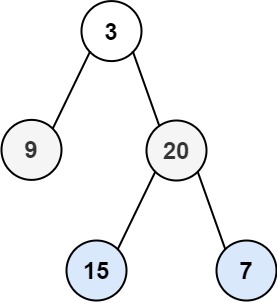Leetcode 107 二叉树的层序遍历II
107.二叉树的层序遍历II
给你二叉树的根节点 root ,返回其节点值 自底向上的层序遍历 。 (即按从叶子节点所在层到根节点所在的层,逐层从左向右遍历)
示例 1:

输入: root = [3,9,20,null,null,15,7]
输出: [[15,7],[9,20],[3]]
示例 2:
输入: root = [1]
输出: [[1]]
示例 3:
输入: root = []
输出: []
提示:
- 树中节点数目在范围
[0, 2000]内 1000 <= Node.val <= 1000
Related Topics
- 树
- 广度优先搜索
- 二叉树
题目链接: link
解答
本题的难度是 Medium.
一开始写的很抽象, 先创建一个 HashMap, 然后记录最大深度, 然后再倒序插入到 result 里.
代码如下:
class Solution {
private int maxDepth = -1;
HashMap<Integer, ArrayList<Integer>> hashMap = new HashMap();
public List<List<Integer>> levelOrderBottom(TreeNode root) {
levelOrder(root, 0);
List<List<Integer>> result = new ArrayList<>();
for (int i = maxDepth; i >= 0 ; i--) {
result.add(hashMap.get(i));
}
return result;
}
private void levelOrder(TreeNode node, int depth){
if (node == null){return;}
if (depth > maxDepth) { maxDepth = depth;}
if (!hashMap.containsKey(depth)){
hashMap.put(depth, new ArrayList<>());
}
ArrayList<Integer> list = hashMap.get(depth);
list.add(node.val);
hashMap.put(depth, list);
levelOrder(node.left, depth+1);
levelOrder(node.right, depth+1);
}
}
1ms, 击败 92.43% 的提交.
然后发现根本不用这样做, 本质还是层序遍历, 把层序遍历倒一下就好了, 于是改了一下.
class Solution {
List<List<Integer>> lists = new ArrayList<>();
public List<List<Integer>> levelOrderBottom(TreeNode root) {
ceng(0, root);
Collections.reverse(lists);
return lists;
}
private void ceng(int cengIndex, TreeNode node){
if(node == null ){return ;}
if(lists.size() < (1+cengIndex)){
lists.add(new ArrayList<>());
}
lists.get(cengIndex).add(node.val);
ceng(cengIndex+1, node.left);
ceng(cengIndex+1, node.right);
}
}
好好好, 0ms, 击败 100% 的提交.